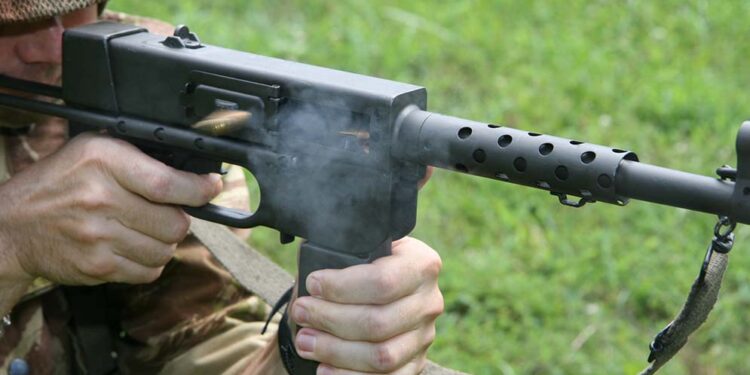By Robert Bruce
“Unfortunately, the Model 1938 was not produced in 9mm parabellum. If this cartridge had been employed, the Model 1938 would have been noted as one of the finest among all of the various submachine guns used in World War II.” Thomas B. Nelson and Hans Lockhoven, The World’s Submachine Guns (Machine Pistols) Volume 1
Alas, the 7.65mm pipsqueak Pistolet Mitrailleur MAS 38, France’s prewar standard submachine gun, wasn’t chambered for the more powerful and nearly universal 9x19mm Parabellum, and that was certainly not its only deficiency in the eyes of France’s postwar leadership. So, let’s examine how this relates to development, design and fielding of the MAT 49; by no means an up-caliber version of the MAS 38.
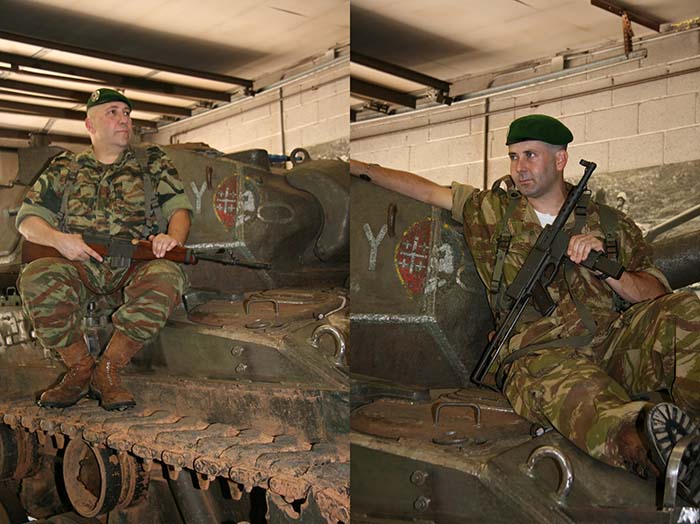
Pride in Postwar France
Seeking to erase the shameful stains of the Vichy government’s collaboration with German occupiers and to rebuild the “glory of the French Republic,” nationalism flourished in many forms. Among these was a multi-faceted effort to modernize France’s ground, air and naval forces.
Even lowly small arms were important in this and the major arsenals were directed to begin development of various weapons of native design that would be better than those of its recent allies and adversaries. While this made sense in a patriotic way, it could not have been an easy decision in the struggling economy of the newly-liberated France, devastated and demoralized by years of war.
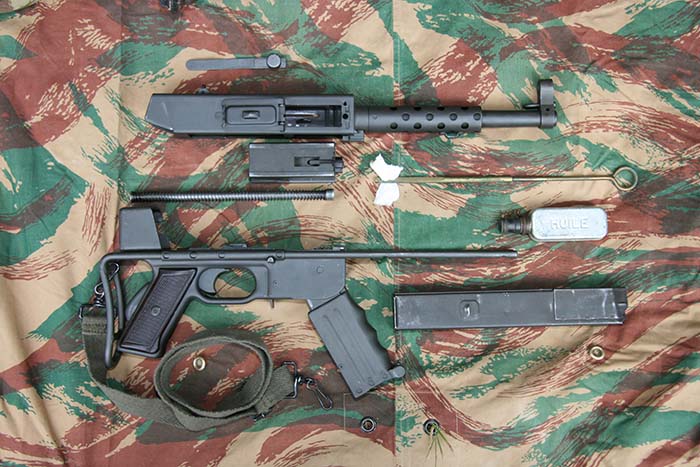
Cheap Surplus Subguns
At the end of WWII in 1945, the planet was awash in surplus small arms of all kinds including submachine guns. Literally millions of perfectly serviceable and demonstrably effective SMGs were available at scrap metal prices.
Some worthies among the combatant forces’ mountains of surplus subs included the rugged Soviet PPSh and PPS in 7.62x25mm Tokarev and the elegant Italian 9mm Beretta Modello 38/42.
America had generously equipped the Free French Forces with powerful .45 caliber Thompsons and M3 “Grease Guns.” Britain had air dropped massive quantities of simple and reliable 9mm Stens to the Maquis resistance fighters, who also had captured plenty of 9mm German MP38 and MP40 submachine guns.
So, why not continue them in use while precious francs were used for other, more pressing problems? Historical documents cite a combination of economic stimulus theory and nearly tangible national pride: Put the domestic armaments industry back on its feet and arm the military with weaponry of distinctively French origin.
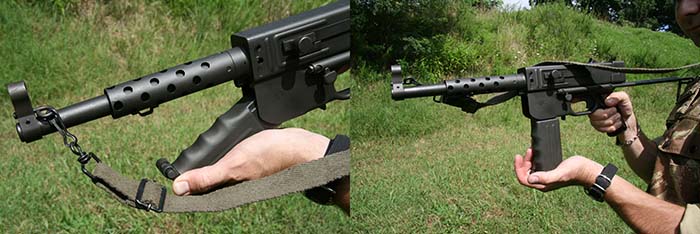
M.A.C., M.A.S. and More
France’s principal weapons manufacturers included M.A.C. (Manufacture d’Armes de Chatellerault), M.A.S. (Manufacture d’Armes de Saint-Etienne), M.A.T. (Manufacture d’Armes de Tulle), and Hotchkiss. Beginning in 1946 in response to government solicitations, all four firms developed 9mm submachine guns with the hope of selection by the military and subsequent, profitable mass production. These went through varying degrees of modification as they progressed through the Army’s intensive evaluation that culminated in early 1949. M.A.C. put forth the 48 L.S., M.A.S. offered the 48 C4, M.A.T. the Modele 48. Hotchkiss came in a bit too late with the “Type Universal.” (Editor’s Note: Photos and details of each these entries and much more can be found in The World’s Submachine Guns (Machine Pistols) Volume 1 (1915 – 1963), Thomas B. Nelson and Hans Lockhoven’s invaluable, encyclopedic reference book, first published in 1963 but, sadly, now out of print).
Interestingly, the MAS 38’s sturdy, heavy, well machined steel receiver fell out of favor. Clearly reflecting mass production techniques and combat success in WW2 of mass-produced allied and axis designs, the four candidates were built around lighter but serviceable, inexpensive sheet steel tubing or stampings. Their other significant commonalities included MP40 and Sten type single-position feed 32-round box magazines, as well as overall compactness from stocks that folded or telescoped, and forward-folding magazine housings. Simplicity of operation came from variations of blowback action in full-auto only (with exception of the semi/full auto Hotchkiss) at manageable cyclic rates at 500 to 650 rpm.
On 20 May 1949, after the last clouds of nitrocellulose propellant drifted away from the test ranges and whatever backroom deals were struck, a product-improved version of M.A.T.’s Modele 48 was named the victor, designated Pistolet Mitrailleur de 9mm Modele 1949.

Anatomy of the MAT 49
The design of the PM MAT 49 – while certainly the work of a project team – is credited to Pierre Monteil, an armaments engineer who later became the top man at MAT. While there are pros and cons to be noted in any firearm, the MAT 49 is generally regarded as an excellent example of postwar design; perhaps a bit heavy but definitely sturdy, soldier-friendly and battle worthy. From the manufacturing standpoint, the gun could be quickly and economically produced, with hydraulic-pressed sheet steel forming its robust, rectangular upper receiver, gracefully curved lower with integral pistol grip, and up-folding magazine housing. Perforated steel tubing shields the barrel and the telescoping stock is made in the manner of the U.S. M3 “Grease Gun” from heavy steel wire that’s bent and welded. A necessary amount of traditional machining is required for the barrel, trunnion, bolt and extractor, with the whole thing being put together mostly with welds and pins.
Likely taking a cue from the twin bolt guide rods inside the U.S. M3 and M3A1 “Grease Guns,” the MAT 49’s bolt rides around a single rod anchored fore and aft at the top of the receiver. This saves the walls of the receiver from wear and provides a bit of clearance alongside the bolt for the grit that inevitably accumulates under arduous operational conditions.
A sturdy spiral-wound recoil spring surrounds the guide rod, telescoping into the body of the bolt. It imparts sufficiently strong forward motion for feeding and firing, then slows the bolt’s rearward “blowback” movement after firing. Its tension is calculated so that no buffer is needed to keep the bolt from smacking against the rear of the receiver.
Traditional phosphate coating with a matte gray tint completes the process, providing durability, rust-resistance and low reflectivity of light.
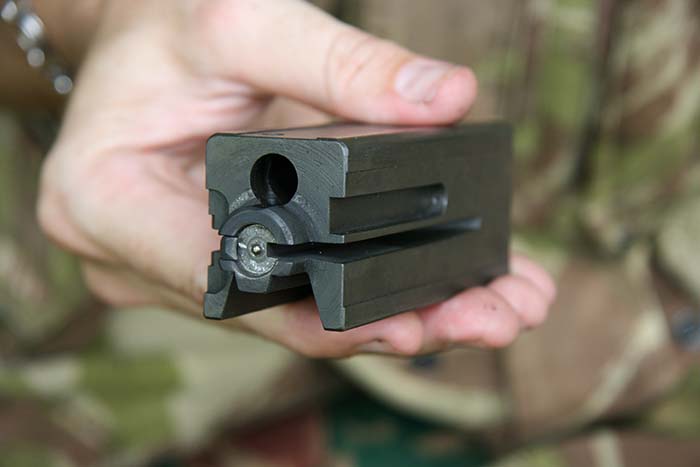
Internal Combustion and External Safety
Perhaps the MAT 49’s most notable engineering innovation comes in response to the problem of premature ignition of a cartridge as it is being pushed from the magazine into the firing chamber. This dangerous situation is common to “slam-fire” subs with fixed firing pins machined into the bolt face.
The unique solution Monteil’s team chose was to extend the face of the bolt so it partially enters an enlarged chamber area, assuring that any premature detonation with resultant case rupture will be safely contained. Additionally, a gas escape tunnel is drilled on both sides of the receiver and through the rear of the chamber to vent the explosion. However, in normal cycling the incoming round is fully seated in the chamber at the moment of detonation and the forward portion of the bolt effectively blocks these holes for both optimal performance of the round and energetic blowback action. We are unaware of any other submachine gun that has been widely-distributed before or since that utilizes this arrangement. Also noteworthy is the controversial decision to dispense with any deliberate mechanical safety other than that built into the pistol grip or by folding the magazine housing in the up position.
The design team’s examination of previous submachine gun designs showed a variety of solutions to minimizing safety hazards inherent in “open bolt/slam fire” operation. The American Thompson, for example, has a manual safety switch that blocks the internal action. Others, like the British Sten, German MP 40 and Soviet PPSh 41, employ simple bolt-arrestors.
But for whatever reasons (no doubt thoroughly considered and exhaustively debated during the trials of 1948-49) the MAT 49 has neither form. Instead, it relies on a grip safety that, unless depressed by a hand on the pistol grip, securely blocks movement of the bolt either rearward or forward. Thus, when a loaded magazine is in place and the bolt is forward on an empty chamber, dropping the weapon on its butt won’t allow inertia to move the bolt back far enough to pick up, chamber and fire a cartridge. Similarly, when the bolt is cocked, the gunner has to properly grasp the pistol grip to fire. When operators are given proper training, this arrangement is considered an acceptable compromise that is both operationally efficient (no need to fumble with an extra safety or selector) and functionally safe.
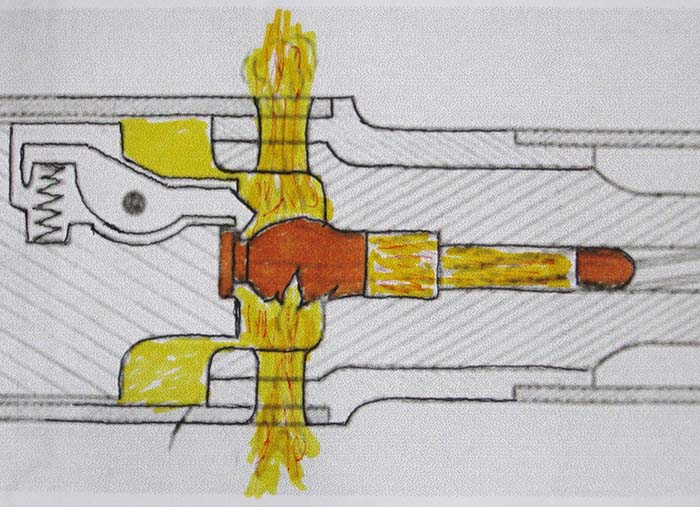
Evolution
First production began at Tulle in late 1949, and then transferred to St-Etienne in 1965, eventually totaling more than 700,000 guns by 1979 when production ended. The original design with its strictly rectangular receiver and “teardrop” grip safety was updated twice.
For recognition purposes, the receiver on Type 2 guns are a bit longer and slightly trapezoidal in shape (receiver a little bit wider at the top than the bottom) when viewed from the rear. Reasons for this odd geometrical reconfiguration were not revealed in extensive research for this article in both English and French language sources. Also, Type 2 guns have a rectangular grip safety, and a star is stamped on the side of the trigger to signal its resized and improved internals.
Type 3 guns, characterized by small changes in order to simplify production, were initiated in 1967 at St-Etienne. These are easily recognized by “MAT MODELE.1949” stamped above the serial number at the rear of the receiver and the all metal pistol grip with raised ribs.
Another variant is the MAT 49/54. Although utilizing the original weapon’s receiver, it is considerably different in outward appearance. Made for the Gendarmerie Nationale (France’s national police), it has a fixed wooden stock and much longer barrel. Some early photos show this gun with two triggers that presumably facilitate semi and full auto fire. More recent ones show these national police carring standard military issue MATs.
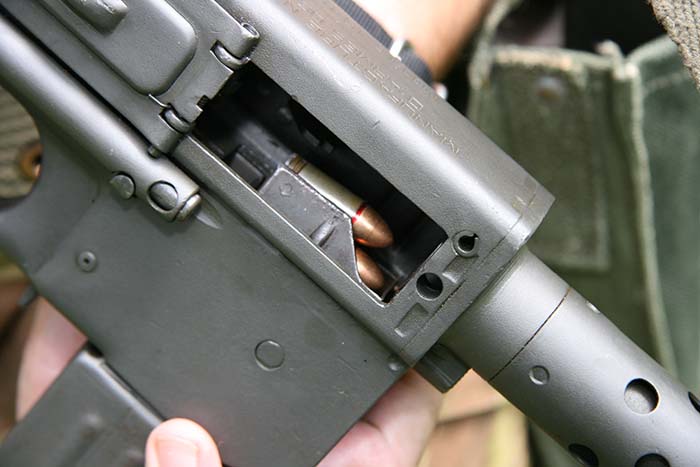
Soldier Friendly?
Several hours on VMMV’s range for live fire and photos with the MAT 49 provided an acceptable amount of time for evaluation. Here are some impressions, not necessarily in order of importance:
First off, we think it’s a good looking weapon with a distinctive profile; compact, thoughtfully configured, and efficient yet classy in form and function – sort of a stylish French makeover of the ugly duckling American “Grease Gun.” Taken as a whole there’s nothing else quite like it given the combo of rectangular receiver, semi-shrouded barrel, telescoping stock, finger-grooved mag housing, and super-simple operation.
That said, it’s heavy as hell – half the size of a Thompson but close to the same weight. Yeah, “heavy helps controllability and sturdy is always heavy” as the conventional wisdom goes. We get it but remain thankful we don’t have to be humping it up and down the hills of Korea, running between bunkers at Dien Bien Phu, or clearing the Kasbah in Algiers.
All metal construction is utilitarian, but will freeze to ungloved hands in the subzero cold of Korean winters. And, even with that mean-looking perforated barrel shroud, burns are a real hazard after a couple of mags in full auto.
Sights are rudimentary – flip-over rear for 100 or 200 meters with a hood-protected fixed front post – and the short sight radius is nothing to write home about. But, how much precision should one reasonably require of a slam-fire, short barrel 9mm kicking out slugs at ten per second?
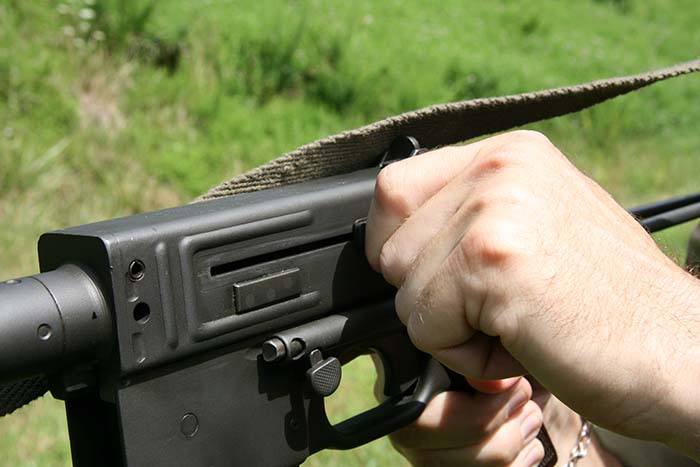
Little retraining is needed for those with a basic amount of experience in sub gunning; mag goes in the hole at the bottom, left side charging handle racks back and you don’t really have to remember to push it forward again. Stays put afterward so it’s not a high speed shuttling hazard.
Speaking of injury or death from accidental discharges, KEEP YOUR FINGER OUTSIDE THE TRIGGER GUARD WHEN CHARGING THE WEAPON AND MAKE SURE TO PULL THE BOLT ALL THE WAY BACK UNTIL IT LOCKS!
Adjust the sight and sling, line up the sights and squeeze. No fumbling with a safety or selector. Buttons and tabs are logically located and readily activated to unlock and swing down the mag housing or unlock and swing it back up again.
Same with dropping a mag, adjusting the stock, and no worries with the self-opening dust cover that’s way better than the Grease Gun’s hinged hatch lid “safety.”
No tools are needed to strip the gun for routine maintenance, the upper and lower receivers fully separate, major parts are easily removed and replaced, and there are no nooks and crannies inside that are hard to get at and clean.
But, Monsieur Monteil, when you directly copied the American M3A1’s wire buttstock, why didn’t you bring forward its clever incorporation of a mag loader (outta luck if you lose the one in the accessory pouch) and tap the ends for a cleaning brush and patch loop? Also, is the bolt’s single guide rod really better than a twin arrangement? And honestly, is that premature detonation mitigation arrangement really needed?
The MAT 49’s mags are glorified Sten or Grease Gun boxes, with single-position feed lips made from indestructibly heavy steel. A twenty rounder is available, but most provide 32 coups (shots). Don’t think you can fill ‘em up without the accessory loader that slips over the top. That said, the gun’s owner showed how one of the tips of the wire stock has a distinct “C” shaped cut that he has used to depress the top round when loading. The American Defense Intelligence Agency’s tech manual says to use a flat blade screwdriver in the cartridge’s extraction groove. When the mag runs dry the bolt closes over an empty chamber. Some like this; some don’t.
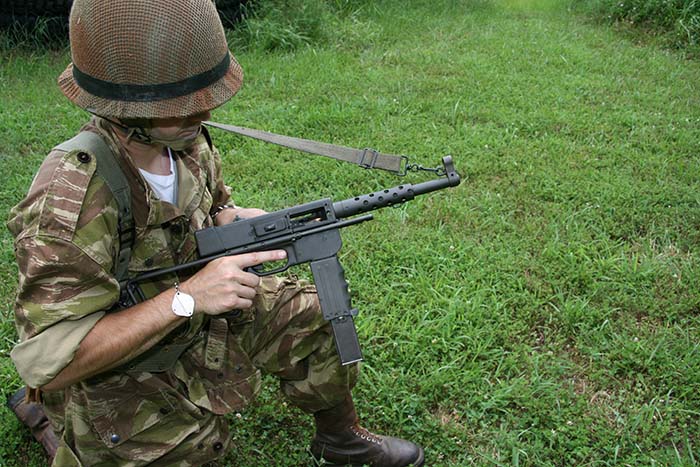
Guerre
As production of the new PM MAT 49 ramped up at Tulle, priority for issue was naturally given to elite formations like the paratroops and commandos. Other elements of the French military continued to use the MAS 38, along with American Thompsons and some Hotchkiss Universals.
Combat action for the MAT 49 came soon enough when a French battalion was committed in 1950 to the United Nations contingent in the Korean War and others were deploying as the communist insurrection in Indochina intensified.
Photos from the Indochina conflict – France desperately trying to reassert postwar control over its resource-rich “protectorates” of Laos, Cambodia and Vietnam – show the MAT 49 side by side with American Carbines and “Tommy Guns,” in the hands of French regulars, Foreign Legionnaires and colonial troops. The little sub’s reliability and effectiveness in the harsh conditions of mountain and jungle warfare earned praise and affection from the men who carried it and others who faced it in battle.
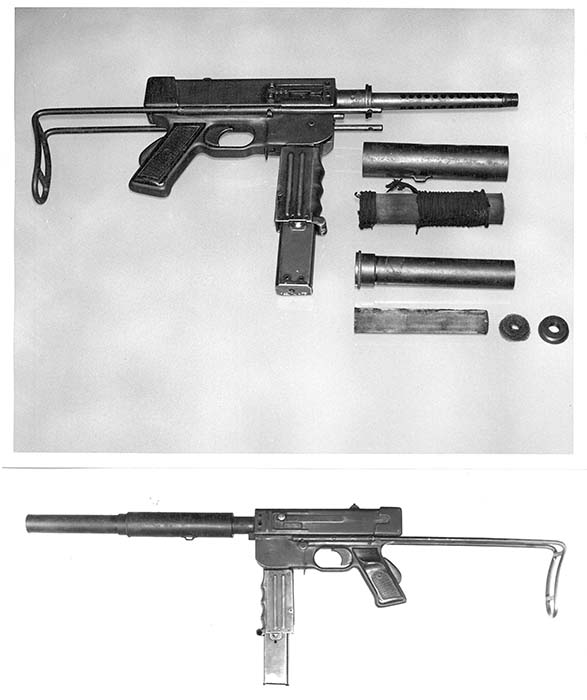
Large numbers of the guns fell into the hands of enemy, who eagerly distributed them in original 9mm caliber and later converted many to fire Communist Bloc 7.62mm Tokarev ammo. Both types were regularly encountered by American forces all during the Vietnam War and the 9mm Type 1 weapon featured in the accompanying live fire photos here was captured in ‘Nam.
Following France’s defeat at the hands of the communist Viet Minh in 1954, the MAT 49 migrated to Algeria with the Foreign Legion and other troops battling socialist/nationalist forces seeking to overthrow French rule. The compact, fast-firing submachine gun was extensively used by both sides, achieving iconic status in newsreels and photos, as well as a starring role in the movies Lost Command and Battle of Algiers.
By this time the MAT 49 was fully integrated into all branches of the French military. In addition to use by designated members of infantry and airborne units, it was being carried by artillerymen and armored fighting vehicle crewmen, naval landing forces, air force security, and others with assigned duties calling for something more potent than a pistol but less cumbersome than a rifle.
More than two dozen countries, most of which have close ties with France, adopted the weapon. It soldiered on in first line French service through numerous small actions in the 1960s and 70s.
The last hurrah for the MAT 49 in Foreign Legion service is said to have come in 1978 during the Kolwezi operation (Zaire/Congo). There, the 9mm sub gun’s limited range and penetrating power compared poorly to the AK type assault rifles employed by many of the Katangan rebels, reinforced by a Cuban division. Yes, the paras had plenty of rifle caliber Mle 1949/52 semi-autos and AAT Mle 52 machine guns, but more reach and knockdown was called for.
The 5.56mm NATO caliber FAMAS, a select fire bullpup of homegrown French design (no surprise there), began replacing both subguns and semi-auto rifles after 1980. The MAT 49 remained in reserve and paramilitary police use for many years, but is rarely encountered today outside of backwater countries.
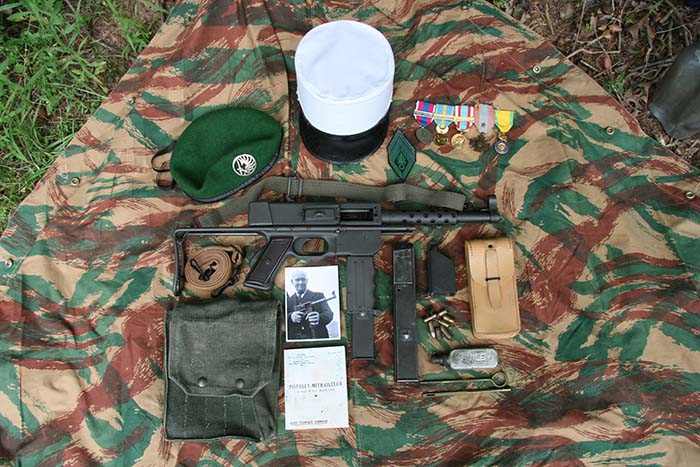
MAT 49 Machine Pistol (Submachine Gun) Technical Specifications
Type 1 version as seen in this feature’s live fire photos. Principal data from The World’s Submachine Guns (Machine Pistols) Volume 1, Nelson and Lockhoven, 1963.
Nomenclature: Pistolet Mitrailleur de 9mm Modele 1949 (Machine Pistol, 9mm, Model 1949)
Country of origin: France
Manufacturer: Manufacture d’Armes de Tulle (M.A.T.)
Cartridge: 9x19mm Parabellum (Luger)
Muzzle velocity: 1,200 fps (365 mps)
Operation: Blowback
Type of fire: Full auto
Cyclic rate: 600 rpm
Length w/ stock extended: 26 inches (660 mm)
Length w/ stock retracted: 16 inches (404 mm)
Barrel: 9 inches long (230 mm), four grooves, left twist, one turn in 10 inches (250 mm)
Feed: Sten type sheet steel box magazines of 20 and 32 round capacity. Double stack, single position feed
Weight: 8 pounds (3.63 kg) unloaded, 9.4 pounds (4.23 kg) with loaded 32 round magazine
Sights: Hood protected fixed blade front and 2-position flip rear marked 100 and 200 meters
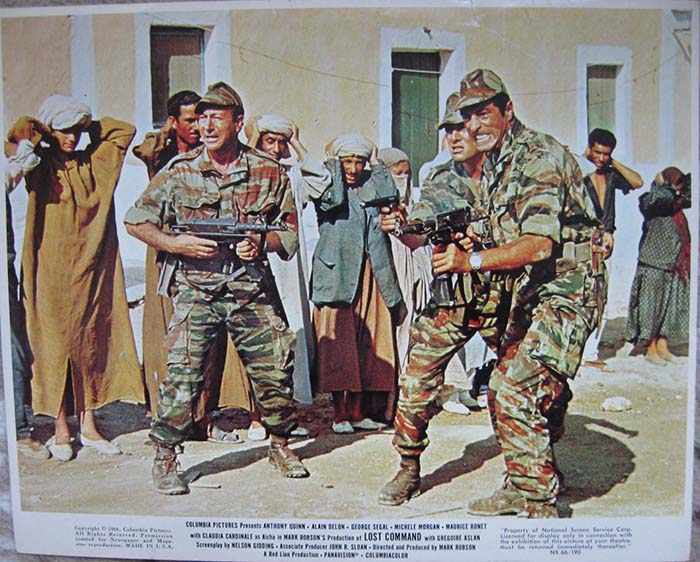
Accessories:
Slings and magazine carriers in leather and canvas web versions, blank firing adapter, magazine loader.
Approximately 700,000 produced from 1950 to 1979 by M.A. Tulle and later M.A. Chatellerault. Principal submachine gun of French armed forces and national police during this period. Replaced in military service circa 1980 by 5.56mm FAMAS assault rifle.
(Special thanks to Marc Sehring, Operations Manager of The Virginia Museum of Military Vehicles (vmmv.org ) for graciously hosting our live fire evaluation, and to Christian Cartner and Ken Lee; French Foreign Legion airborne infantry living history enthusiasts of Regiment Etranger de Parachutistes, Cie de Combat (email la_boudin@yahoo.com ). And certainly to the intentionally unnamed owner who accompanied his Vietnam battlefield-captured (and amnesty-registered) PM MAT 49 that we put through the live fire wringer.)
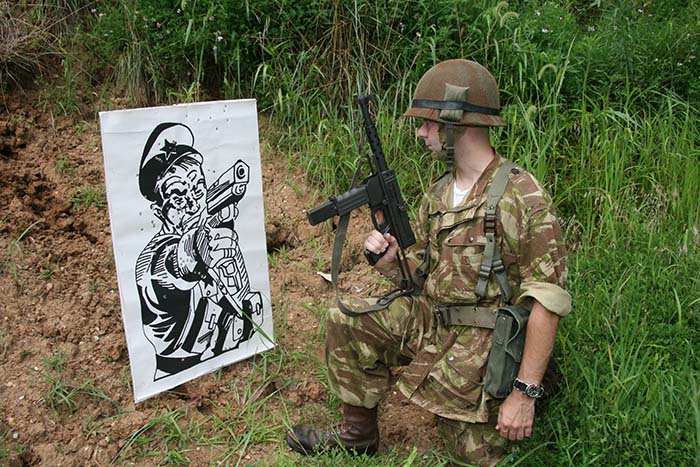
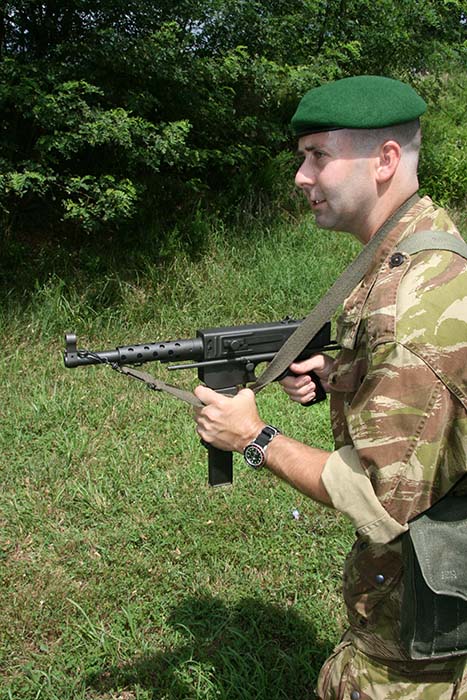
| This article first appeared in Small Arms Review V18N3 (June 2014) |



